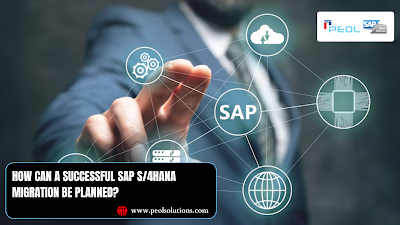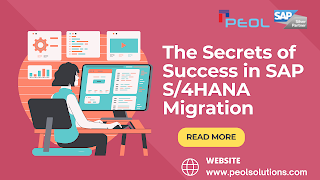How can a successful SAP S/4HANA migration be planned?
Introduction:
The digital world is changing rapidly, and businesses are implementing SAP S/4HANA to enhance speed, simplify operations, and enable real-time data access. The catch is that, unless a comprehensive migration plan is in place, even the most powerful ERP systems can quickly become overwhelming. The migration from SAP S/4HANA to SAP HANA is more than a technical project; it is a journey of business transformation as well. The purpose of this guide is to provide you with the strategies and steps needed to ensure that your migration to the new software is smooth, cost-effective, and future-proof.
Start with a Clear Business Case:
A company must define why it wants to migrate to SAP S/4HANA before beginning the migration process. What is the purpose of enabling real-time analytics? Reducing the complexity of operations? How can we support future innovation? Your migration will deliver real business value only if you identify specific objectives, such as improving supply chain efficiency or simplifying IT infrastructure. Having a clear business case assists in justifying the investment to stakeholders and aligns every step of the migration with the company's strategic goals.
Choose the Right Deployment Model:
S/4HANA is available in three deployment options: on-premises, cloud-based (public or private), and hybrid deployments. Each comes with its pros and cons. Cloud options offer scalability and faster implementation, while on-premises gives you greater control. The key is to evaluate what suits your current IT ecosystem, budget, and long-term business goals. Don’t just follow trends. Choose a model that works for you.
Conduct a Comprehensive System Assessment:
Understanding where you're going is the first step. Perform a thorough analysis of your existing SAP landscape: custom codes, data quality, interfaces, and workflows. This step will help you determine whether a Greenfield (new implementation), Brownfield (system conversion), or Bluefield (selective transformation) approach is best. Also, identify redundant or outdated processes that can be retired in the new system.
Define Your Migration Strategy:
A successful migration starts with the right strategy. Greenfield migrations are ideal for companies wanting a complete redesign. Brownfield is quicker and retains historical data and configurations. Bluefield offers flexibility by combining both. Once you choose the approach, define the project timeline, milestones, and KPIs. Your strategy should be realistic, agile, and tailored to your organizational needs.
Engage the Right Team and Partners:
Migration success heavily relies on people. Assemble a cross-functional team that includes IT experts, business users, and a project manager with SAP experience. It’s also wise to engage experienced SAP S/4HANA migration consultants or certified partners who’ve been through the process multiple times. Their insights can prevent costly mistakes and accelerate progress.
Focus on Data Cleansing and Readiness:
S/4HANA is data-driven, so poor data quality can cause problems. Take this opportunity to clean, validate, and harmonize your data. Remove obsolete data, standardize formats, and establish governance policies. Data migration tools like SAP Data Services or SAP Migration Cockpit can streamline this phase. The cleaner your data, the smoother your migration and future reporting will be.
Prioritize Change Management and Training:
Migration isn’t just about systems, it’s about people adapting to change. Put together a solid change management plan. Communicate the benefits clearly to stakeholders. Training end-users on the new interfaces and processes to reduce resistance and maximize adoption. Offering hands-on workshops, quick-reference guides, and helpdesk support during go-live can make all the difference.
Test, Test, and Test Again:
Don’t leave testing as an afterthought. Perform multiple rounds of unit, integration, and user acceptance testing (UAT) to identify and fix issues early. Simulating real-world scenarios to ensure workflows, authorizations, and reports function as expected. Testing gives you confidence that your system is ready for a smooth go-live.
Execute a Controlled Cutover Plan:
We shouldn't be taking a leap of faith when we go live. Prepare a detailed cut-over plan that includes system backups, final data migration, validation checks, rollback strategies, and a clear communication plan. Choose a low-traffic period if possible and monitor system performance closely for the first few weeks. A strong support team should be on standby to resolve any hiccups.
Post-Go-Live Support and Continuous Optimization:
The migration process doesn't end when you go live. Monitor the performance of the system, collect feedback from users, and resolve post-go-live issues as soon as possible. Utilize insights gained during this phase to fine-tune workflows, enhance reporting, and plan future upgrades. It is important to conduct regular system audits and user training to maintain momentum and maximize return on investment.
Conclusions:
An SAP S/4HANA migration is a significant milestone that can change the way your business operates forever. The right planning, tools, and team can help you avoid pitfalls and position your company for future success. Think of it as more than a simple IT upgrade; it is a platform for intelligent enterprise growth.
For More Details:
Call: +91-8040905243
Mail: sales@peolsolutions.com
Visit: www.peolsolutions.com




Comments
Post a Comment